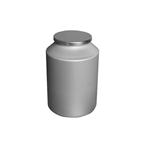Chemical Properties
colorless liquid. Soluble in chloroform, miscible with ethanol and ether, insoluble in water, and will change color when exposed to light or left for a long time.
Uses
1-Iodobutane was used in the synthesis of S-alkylated 5-(2-,3- and 4-methoxyphenyl)-4H-1,2,4-triazole-3-thiol and 5-(2-,3- and 4-methoxyphenyl)-4-phenyl-4H-1,2,4-triazole-3-thiol. It is also used in wide range of medicals industrial applications as well as in human and animal nutrition products, pharmaceutical intermediates, polarizing films for Liquid Crystal Display (LCD) chemicals.
Preparation
1-Iodobutane is obtained by reacting n-butanol with iodine in the presence of phosphorus.
Synthesis Reference(s)
The Journal of Organic Chemistry, 44, p. 2048, 1979
DOI: 10.1021/jo01326a042Synthesis, p. 114, 1976
General Description
Thermal chemistry of 1-iodobutane has been investigated on clean and hydrogen- and deuterium-predosed Pt(111) single-crystal surfaces by temperature-programmed desorption and reflection-absorption infrared spectroscopy.
Purification Methods
Dry the iodide with MgSO4 or P2O5, fractionally distil it through a column packed with glass helices, taking the middle fraction and storing over calcium or mercury in the dark. Alternatively purify it by prior passage through activated alumina or by shaking with conc H2SO4 then washing with Na2SO3 solution. It has also been treated carefully with sodium to remove free HI and H2O, before distilling through a column containing copper turnings at the top. Another purification procedure consisted of treatment with bromine, followed by extraction of free halogen with Na2S2O3, washing with H2O, drying and fractionally distilling. [Beilstein 1 IV 271.]





